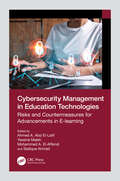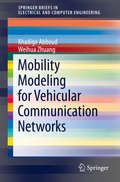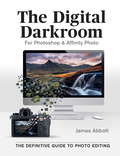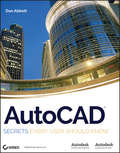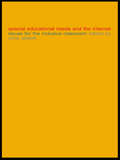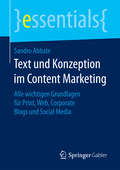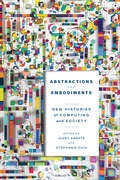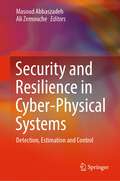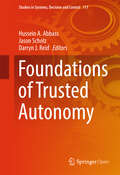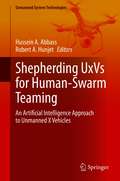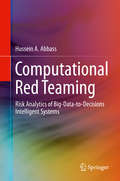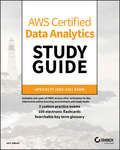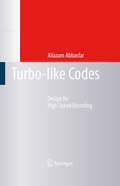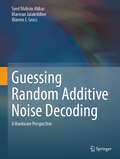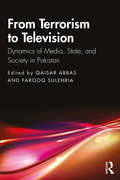- Table View
- List View
Cybersecurity Management in Education Technologies: Risks and Countermeasures for Advancements in E-learning
by Abd El-Latif, Ahmed A.This book explores the intersection of cybersecurity and education technologies, providing practical solutions, detection techniques, and mitigation strategies to ensure a secure and protected learning environment in the face of evolving cyber threats. With a wide range of contributors covering topics from immersive learning to phishing detection, this book is a valuable resource for professionals, researchers, educators, students, and policymakers interested in the future of cybersecurity in education. Features: • Offers both theoretical foundations and practical guidance for fostering a secure and protected environment for educational advancements in the digital age. • Addresses the need for cybersecurity in education in the context of worldwide changes in education sources and advancements in technology. • Highlights the significance of integrating cybersecurity into educational practices and protecting sensitive information to ensure students’ performance prediction systems are not misused. • Covers a wide range of topics including immersive learning, cybersecurity education, and malware detection, making it a valuable resource for professionals, researchers, educators, students, and policymakers.
Software Architecture with C# 9 and .NET 5: Architecting software solutions using microservices, DevOps, and design patterns for Azure
by Francesco Abbruzzese Gabriel BaptistaDesign scalable and high-performance enterprise applications using the latest features of C# 9 and .NET 5 IMOKey FeaturesGain fundamental and comprehensive software architecture knowledge and the skillset to create fully modular appsDesign high-performance software systems using the latest features of .NET 5 and C# 9Solve scalability problems in web apps using enterprise architecture patternsBook DescriptionSoftware architecture is the practice of implementing structures and systems that streamline the software development process and improve the quality of an app. This fully revised and expanded second edition, featuring the latest features of .NET 5 and C# 9, enables you to acquire the key skills, knowledge, and best practices required to become an effective software architect. This second edition features additional explanation of the principles of Software architecture, including new chapters on Azure Service Fabric, Kubernetes, and Blazor. It also includes more discussion on security, microservices, and DevOps, including GitHub deployments for the software development cycle. You will begin by understanding how to transform user requirements into architectural needs and exploring the differences between functional and non-functional requirements. Next, you will explore how to carefully choose a cloud solution for your infrastructure, along with the factors that will help you manage your app in a cloud-based environment. Finally, you will discover software design patterns and various software approaches that will allow you to solve common problems faced during development. By the end of this book, you will be able to build and deliver highly scalable enterprise-ready apps that meet your organization's business requirements.What you will learnUse different techniques to overcome real-world architectural challenges and solve design consideration issuesApply architectural approaches such as layered architecture, service-oriented architecture (SOA), and microservicesLeverage tools such as containers, Docker, Kubernetes, and Blazor to manage microservices effectivelyGet up to speed with Azure tools and features for delivering global solutionsProgram and maintain Azure Functions using C# 9 and its latest featuresUnderstand when it is best to use test-driven development (TDD) as an approach for software developmentWrite automated functional test casesGet the best of DevOps principles to enable CI/CD environmentsWho this book is forThis book is for engineers and senior software developers aspiring to become architects or looking to build enterprise applications with the .NET Stack. Basic familiarity with C# and .NET is required to get the most out of this book.
Hands-On TypeScript for C# and .NET Core Developers: Transition from C# to TypeScript 3.1 and build applications with ASP.NET Core 2
by Francesco AbbruzzeseDiscover how TypeScript allows you to build modern client-rich applications, thanks to its object-oriented capabilities and third-party tools like Angular and Web APIs Key Features Make a seamless transition to using TypeScript 3.1 in your development stack Work with TypeScript 3.1 in your ASP.NET Core projects to build rich applications that are easy to maintain Build, test, and integrate your own TypeScript library in real-world projects Book Description Writing clean, object-oriented code in JavaScript gets trickier and complex as the size of the project grows. This is where Typescript comes into the picture; it lets you write pure object-oriented code with ease, giving it the upper hand over JavaScript. This book introduces you to basic TypeScript concepts by gradually modifying standard JavaScript code, which makes learning TypeScript easy for C# ASP.NET developers. As you progress through the chapters, you'll cover object programming concepts, such as classes, interfaces, and generics, and understand how they are related to, and similar in, both ES6 and C#. You will also learn how to use bundlers like WebPack to package your code and other resources. The book explains all concepts using practical examples of ASP.NET Core projects, and reusable TypeScript libraries. Finally, you'll explore the features that TypeScript inherits from either ES6 or C#, or both of them, such as Symbols, Iterables, Promises, and Decorators. By the end of the book, you'll be able to apply all TypeScript concepts to understand the Angular framework better, and you'll have become comfortable with the way in which modules, components, and services are defined and used in Angular. You'll also have gained a good understanding of all the features included in the Angular/ASP.NET Core Visual Studio project template. What you will learn Organize, test, and package large TypeScript code base Add TypeScript to projects using TypeScript declaration files Perform DOM manipulation with TypeScript Develop Angular projects with the Visual Studio Angular project template Define and use inheritance, abstract classes, and methods Leverage TypeScript-type compatibility rules Use WebPack to bundle JavaScript and other resources such as CSS to improve performance Build custom directives and attributes, and learn about animations Who this book is for If you're a C# or .NET developer looking for an easy accessible way of learning TypeScript, this book is for you.
Hands-On TypeScript for C# and .NET Core Developers: Transition from C# to TypeScript 3.1 and build applications with ASP.NET Core 2
by Francesco AbbruzzeseDiscover how TypeScript allows you to build modern client-rich applications, thanks to its object-oriented capabilities and third-party tools like Angular and Web APIs Key Features Make a seamless transition to using TypeScript 3.1 in your development stack Work with TypeScript 3.1 in your ASP.NET Core projects to build rich applications that are easy to maintain Build, test, and integrate your own TypeScript library in real-world projects Book Description Writing clean, object-oriented code in JavaScript gets trickier and complex as the size of the project grows. This is where Typescript comes into the picture; it lets you write pure object-oriented code with ease, giving it the upper hand over JavaScript. This book introduces you to basic TypeScript concepts by gradually modifying standard JavaScript code, which makes learning TypeScript easy for C# ASP.NET developers. As you progress through the chapters, you'll cover object programming concepts, such as classes, interfaces, and generics, and understand how they are related to, and similar in, both ES6 and C#. You will also learn how to use bundlers like WebPack to package your code and other resources. The book explains all concepts using practical examples of ASP.NET Core projects, and reusable TypeScript libraries. Finally, you'll explore the features that TypeScript inherits from either ES6 or C#, or both of them, such as Symbols, Iterables, Promises, and Decorators. By the end of the book, you'll be able to apply all TypeScript concepts to understand the Angular framework better, and you'll have become comfortable with the way in which modules, components, and services are defined and used in Angular. You'll also have gained a good understanding of all the features included in the Angular/ASP.NET Core Visual Studio project template. What you will learn Organize, test, and package large TypeScript code base Add TypeScript to projects using TypeScript declaration files Perform DOM manipulation with TypeScript Develop Angular projects with the Visual Studio Angular project template Define and use inheritance, abstract classes, and methods Leverage TypeScript-type compatibility rules Use WebPack to bundle JavaScript and other resources such as CSS to improve performance Build custom directives and attributes, and learn about animations Who this book is for If you're a C# or .NET developer looking for an easy accessible way of learning TypeScript, this book is for you.
Hands-On TypeScript for C# and .NET Core Developers: Transition From C# To Typescript 3. 1 And Build Applications With Asp. Net Core 2
by Francesco AbbruzzeseWriting clean, object-oriented code in JavaScript gets trickier and complex as the size of the project grows. This is where Typescript comes into the picture; it lets you write pure object-oriented code with ease, giving it the upper hand over JavaScript. This book introduces you to basic TypeScript concepts by gradually modifying standard JavaScript code
Mobility Modeling for Vehicular Communication Networks (SpringerBriefs in Electrical and Computer Engineering)
by Khadige Abboud Weihua ZhuangThis brief presents a stochastic microscopic mobility model that describes the temporal changes of intervehicle distances. The model is consistent with simulated and empirical vehicle traffic patterns. Using stochastic lumpability methods, the proposed mobility model is mapped into an aggregated mobility model that describes the mobility of a group of vehicles. In addition, the proposed mobility model is used to analyze the spatiotemporal VANET topology. Two metrics are proposed to characterize the impact of vehicle mobility on VANET topology: the time period between successive changes in communication link state (connection and disconnection) and the time period between successive changes in node’s one-hop neighborhood. Using the proposed lumped group mobility model, the two VANET topology metrics are probabilistically characterized for different vehicular traffic flow conditions. Furthermore, the limiting behavior of a system of two-hop vehicles and the overlap-state of their coverage ranges is modeled, and the steady-state number of common vehicle neighbors between the two vehicles is approximately derived. The proposed mobility model will facilitate mathematical analysis in VANETs. The spatiotemporal VANET topology analysis provides a useful tool for the development of mobility-aware vehicular network protocols. Mobility Modeling for Vehicular Communication Networks is designed for researchers, developers, and professionals involved with vehicular communications. It is also suitable for advanced-level students interested in communications, transport infrastructure, and infotainment applications.
Voice Enabling Web Applications: VoiceXML and Beyond
by Ken AbbottDevelopers can use the same technology to build both automated voice services as well as visual Web sites, and Ken Abbott shows how in this comprehensive introduction to the syntax, concepts and strategies relevant to VoiceXML.
The Digital Darkroom: The Definitive Guide to Photo Editing
by James AbbottPost-production can make the difference between a good image and a great image, not to mention it's an essential process if you shoot in RAW to enjoy the most flexibility and control possible. This book will outline everything you need to know to gain a better understanding of how to apply darkroom style effects to your images using Adobe Photoshop and Affinity Photo.Through detailed background knowledge designed to make you familiar with the software and to build your confidence, you'll learn a wide range of skills and techniques through step-by-step case studies that will make learning an active experience. Not only will this be a valuable reference resource, it will also be your very own personal tutor giving you everything you need to edit your images like a pro. - Learn the essentials with a complete guide to every tool, filter and effect for both Adobe Photoshop and Affinity Photo- Get the most out of your RAW files with detailed instructions on processing your digital image- Master basic, intermediate, and advanced editing techniques with easy to follow step-by-step tutorials- Get the best quality images for display with a complete guide to home printing
Applied Predictive Analytics: Principles and Techniques for the Professional Data Analyst
by Dean AbbottLearn the art and science of predictive analytics — techniques that get results Predictive analytics is what translates big data into meaningful, usable business information. Written by a leading expert in the field, this guide examines the science of the underlying algorithms as well as the principles and best practices that govern the art of predictive analytics. It clearly explains the theory behind predictive analytics, teaches the methods, principles, and techniques for conducting predictive analytics projects, and offers tips and tricks that are essential for successful predictive modeling. Hands-on examples and case studies are included. The ability to successfully apply predictive analytics enables businesses to effectively interpret big data; essential for competition today This guide teaches not only the principles of predictive analytics, but also how to apply them to achieve real, pragmatic solutions Explains methods, principles, and techniques for conducting predictive analytics projects from start to finish Illustrates each technique with hands-on examples and includes as series of in-depth case studies that apply predictive analytics to common business scenarios A companion website provides all the data sets used to generate the examples as well as a free trial version of software Applied Predictive Analytics arms data and business analysts and business managers with the tools they need to interpret and capitalize on big data.
Applied Predictive Analytics: Principles and Techniques for the Professional Data Analyst
by Dean AbbottLearn the art and science of predictive analytics — techniques that get results Predictive analytics is what translates big data into meaningful, usable business information. Written by a leading expert in the field, this guide examines the science of the underlying algorithms as well as the principles and best practices that govern the art of predictive analytics. It clearly explains the theory behind predictive analytics, teaches the methods, principles, and techniques for conducting predictive analytics projects, and offers tips and tricks that are essential for successful predictive modeling. Hands-on examples and case studies are included. The ability to successfully apply predictive analytics enables businesses to effectively interpret big data; essential for competition today This guide teaches not only the principles of predictive analytics, but also how to apply them to achieve real, pragmatic solutions Explains methods, principles, and techniques for conducting predictive analytics projects from start to finish Illustrates each technique with hands-on examples and includes as series of in-depth case studies that apply predictive analytics to common business scenarios A companion website provides all the data sets used to generate the examples as well as a free trial version of software Applied Predictive Analytics arms data and business analysts and business managers with the tools they need to interpret and capitalize on big data.
AutoCAD: Secrets Every User Should Know
by Dan Abbott"I've been using AutoCAD for 22 years and have written a hundred books on the subject. I reviewed many CAD books back in the days when book reviews were common in CAD publications; some were innovative, others were just sad. But for nearly a decade, it's been mostly silence on the book review front. Then earlier in the summer, a book arrived in the mail from Sybex: AutoCAD Secrets Every User Should Know by Dan Abbott. Reading it, I got excited: here's a book for every AutoCAD user, even old-timers like me." - Ralph Grabowski, Editor, upFront.eZine.com: The Business of CAD Learn the "why" behind the "how" in this one-of-a-kind reference packed with tips and techniques from award-winning AutoCAD expert Dan Abbott. This info-packed guide reveals some of the best kept AutoCAD secrets on technical standards, AutoLISP programming, DOS functions, scripts, 3D, and everything in between. Based on his popular "Things Every AutoCAD User Should Know" session at Autodesk University and other industry events, Dan gives you the answers to frequently asked AutoCAD questions in his direct and entertaining style while using real-world case studies to put your skills into practice. Read it cover to cover or dive right in to the sections you need most, then get ready to improve your productivity, save more time, and become an AutoCAD all-star.
Special Educational Needs and the Internet: Issues for the Inclusive Classroom
by Chris AbbottWith Internet access for every school now a reality, teachers are beginning to explore the use of the Internet in the education of children with special needs. This book describes its benefits for children across the spectrum of special educational needs, from those with physical disabilities or sensory impairment to those with learning or social difficulties.With contributions from leading practitioners in the field, this book addresses the huge range of possibilities the Internet and associated technology offer for these pupils. Combining current theory and debate with practical guidance and inspiring case studies, this book considers:* how the Internet can be used to gather and publish information* how to communicate effectively through technology* policy and management issues for schools* the continuing challenges for access and inclusion.This book will be of interest to all teachers involved in special education needs, in both mainstream and special schools.
Special Educational Needs and the Internet: Issues for the Inclusive Classroom
by Chris AbbottWith Internet access for every school now a reality, teachers are beginning to explore the use of the Internet in the education of children with special needs. This book describes its benefits for children across the spectrum of special educational needs, from those with physical disabilities or sensory impairment to those with learning or social difficulties.With contributions from leading practitioners in the field, this book addresses the huge range of possibilities the Internet and associated technology offer for these pupils. Combining current theory and debate with practical guidance and inspiring case studies, this book considers:* how the Internet can be used to gather and publish information* how to communicate effectively through technology* policy and management issues for schools* the continuing challenges for access and inclusion.This book will be of interest to all teachers involved in special education needs, in both mainstream and special schools.
Text und Konzeption im Content Marketing: Alle wichtigen Grundlagen für Print, Web, Corporate Blogs und Social Media (essentials)
by Sandro AbbateIn diesem essential erfahren Sie alle wichtigen Grundlagen der Text- und Konzeptentwicklung für eine Content-Marketing-Strategie. Der Autor beschreibt die erfolgsentscheidenden Stellschrauben, die Sie beachten müssen und in die Sie ausreichend Zeit investieren sollten: von der vorab zu leistenden Denkarbeit, über die strukturierte Konzeptentwicklung, bis hin zur optimalen Textarbeit für Webtexte. Abgerundet wird dieser Band durch Interviews mit renommierten Experten und Erfolgsbeispielen aus der Praxis.
Abstractions and Embodiments: New Histories of Computing and Society (Studies in Computing and Culture)
by Janet Abbate Stephanie DickCutting-edge historians explore ideas, communities, and technologies around modern computing to explore how computers mediate social relations.Computers have been framed both as a mirror for the human mind and as an irreducible other that humanness is defined against, depending on different historical definitions of "humanness." They can serve both liberation and control because some people's freedom has historically been predicated on controlling others. Historians of computing return again and again to these contradictions, as they often reveal deeper structures.Using twin frameworks of abstraction and embodiment, a reformulation of the old mind-body dichotomy, this anthology examines how social relations are enacted in and through computing. The authors examining "Abstraction" revisit central concepts in computing, including "algorithm," "program," "clone," and "risk." In doing so, they demonstrate how the meanings of these terms reflect power relations and social identities. The section on "Embodiments" focuses on sensory aspects of using computers as well as the ways in which gender, race, and other identities have shaped the opportunities and embodied experiences of computer workers and users. Offering a rich and diverse set of studies in new areas, the book explores such disparate themes as disability, the influence of the punk movement, working mothers as technical innovators, and gaming behind the Iron Curtain. Abstractions and Embodiments reimagines computing history by questioning canonical interpretations, foregrounding new actors and contexts, and highlighting neglected aspects of computing as an embodied experience. It makes the profound case that both technology and the body are culturally shaped and that there can be no clear distinction between social, intellectual, and technical aspects of computing. Contributors: Janet Abbate, Marc Aidinoff, Troy Kaighin Astarte, Ekaterina Babinsteva, André Brock, Maarten Bullynck, Jiahui Chan, Gerardo Con Diaz, Liesbeth De Mol, Stephanie Dick, Kelcey Gibbons, Elyse Graham, Michael J. Halvorson, Mar Hicks, Scott Kushner, Xiaochang Li, Zachary Loeb, Lisa Nakamura, Tiffany Nichols, Laine Nooney, Elizabeth Petrick, Cierra Robson, Hallam Stevens, Jaroslav Švelch
Security and Resilience in Cyber-Physical Systems: Detection, Estimation and Control
by Masoud Abbaszadeh Ali ZemoucheThis book discusses the latest advances in cyber-physical security and resilience of cyber-physical systems, including cyber-attack detection, isolation, situation awareness, resilient estimation and resilient control under attack. It presents both theoretical results and important applications of the methods. Security and Resilience in Cyber-Physical Systems begins by introducing the topic of cyber-physical security, covering state-of-the-art trends in both theory and applications, as well as some of the emerging methodologies and future directions for research. It then moves on to detail theoretical methods of attack detection, resilient estimation and control within cyber-physical systems, before discussing their various applications, such as power generation and distribution, autonomous systems, wireless communication networks and chemical plants. Focusing on the detection of and accommodation to cyber-attacks on cyber-physical systems, and including both estimation and artificial-intelligence-based methods, this book will be of interest to researchers, engineers and graduate students within the fields of cyber-physical security and resilient control.
Foundations of Trusted Autonomy (Studies in Systems, Decision and Control #117)
by Hussein A. Abbass Jason Scholz Darryn J. ReidThis book establishes the foundations needed to realize the ultimate goals for artificial intelligence, such as autonomy and trustworthiness. Aimed at scientists, researchers, technologists, practitioners, and students, it brings together contributions offering the basics, the challenges and the state-of-the-art on trusted autonomous systems in a single volume. The book is structured in three parts, with chapters written by eminent researchers and outstanding practitioners and users in the field. The first part covers foundational artificial intelligence technologies, while the second part covers philosophical, practical and technological perspectives on trust. Lastly, the third part presents advanced topics necessary to create future trusted autonomous systems. The book augments theory with real-world applications including cyber security, defence and space.
Shepherding UxVs for Human-Swarm Teaming: An Artificial Intelligence Approach to Unmanned X Vehicles (Unmanned System Technologies)
by Hussein A. Abbass Robert A. HunjetThis book draws inspiration from natural shepherding, whereby a farmer utilizes sheepdogs to herd sheep, to inspire a scalable and inherently human friendly approach to swarm control. The book discusses advanced artificial intelligence (AI) approaches needed to design smart robotic shepherding agents capable of controlling biological swarms or robotic swarms of unmanned vehicles. These smart shepherding agents are described with the techniques applicable to the control of Unmanned X Vehicles (UxVs) including air (unmanned aerial vehicles or UAVs), ground (unmanned ground vehicles or UGVs), underwater (unmanned underwater vehicles or UUVs), and on the surface of water (unmanned surface vehicles or USVs). This book proposes how smart ‘shepherds’ could be designed and used to guide a swarm of UxVs to achieve a goal while ameliorating typical communication bandwidth issues that arise in the control of multi agent systems. The book covers a wide range of topics ranging from the design of deep reinforcement learning models for shepherding a swarm, transparency in swarm guidance, and ontology-guided learning, to the design of smart swarm guidance methods for shepherding with UGVs and UAVs. The book extends the discussion to human-swarm teaming by looking into the real-time analysis of human data during human-swarm interaction, the concept of trust for human-swarm teaming, and the design of activity recognition systems for shepherding.Presents a comprehensive look at human-swarm teaming;Tackles artificial intelligence techniques for swarm guidance;Provides artificial intelligence techniques for real-time human performance analysis.
Computational Red Teaming: Risk Analytics of Big-Data-to-Decisions Intelligent Systems (Ieee Press Series On Computational Intelligence Ser.)
by Hussein A. AbbassWritten to bridge the information needs of management and computational scientists, this book presents the first comprehensive treatment of Computational Red Teaming (CRT). The author describes an analytics environment that blends human reasoning and computational modeling to design risk-aware and evidence-based smart decision making systems. He presents the Shadow CRT Machine, which shadows the operations of an actual system to think with decision makers, challenge threats, and design remedies. This is the first book to generalize red teaming (RT) outside the military and security domains and it offers coverage of RT principles, practical and ethical guidelines. The author utilizes Gilbert’s principles for introducing a science. Simplicity: where the book follows a special style to make it accessible to a wide range of readers. Coherence: where only necessary elements from experimentation, optimization, simulation, data mining, big data, cognitive information processing, and system thinking are blended together systematically to present CRT as the science of Risk Analytics and Challenge Analytics. Utility: where the author draws on a wide range of examples, ranging from job interviews to Cyber operations, before presenting three case studies from air traffic control technologies, human behavior, and complex socio-technical systems involving real-time mining and integration of human brain data in the decision making environment.
Learning Apache Spark 2
by Muhammad Asif AbbasiLearn about the fastest-growing open source project in the world, and find out how it revolutionizes big data analytics About This Book • Exclusive guide that covers how to get up and running with fast data processing using Apache Spark • Explore and exploit various possibilities with Apache Spark using real-world use cases in this book • Want to perform efficient data processing at real time? This book will be your one-stop solution. Who This Book Is For This guide appeals to big data engineers, analysts, architects, software engineers, even technical managers who need to perform efficient data processing on Hadoop at real time. Basic familiarity with Java or Scala will be helpful. The assumption is that readers will be from a mixed background, but would be typically people with background in engineering/data science with no prior Spark experience and want to understand how Spark can help them on their analytics journey. What You Will Learn • Get an overview of big data analytics and its importance for organizations and data professionals • Delve into Spark to see how it is different from existing processing platforms • Understand the intricacies of various file formats, and how to process them with Apache Spark. • Realize how to deploy Spark with YARN, MESOS or a Stand-alone cluster manager. • Learn the concepts of Spark SQL, SchemaRDD, Caching and working with Hive and Parquet file formats • Understand the architecture of Spark MLLib while discussing some of the off-the-shelf algorithms that come with Spark. • Introduce yourself to the deployment and usage of SparkR. • Walk through the importance of Graph computation and the graph processing systems available in the market • Check the real world example of Spark by building a recommendation engine with Spark using ALS. • Use a Telco data set, to predict customer churn using Random Forests. In Detail Spark juggernaut keeps on rolling and getting more and more momentum each day. Spark provides key capabilities in the form of Spark SQL, Spark Streaming, Spark ML and Graph X all accessible via Java, Scala, Python and R. Deploying the key capabilities is crucial whether it is on a Standalone framework or as a part of existing Hadoop installation and configuring with Yarn and Mesos. The next part of the journey after installation is using key components, APIs, Clustering, machine learning APIs, data pipelines, parallel programming. It is important to understand why each framework component is key, how widely it is being used, its stability and pertinent use cases. Once we understand the individual components, we will take a couple of real life advanced analytics examples such as ҂uilding a Recommendation system', Ґredicting customer churn' and so on. The objective of these real life examples is to give the reader confidence of using Spark for real-world problems. Style and approach With the help of practical examples and real-world use cases, this guide will take you from scratch to building efficient data applications using Apache Spark. You will learn all about this excellent data processing engine in a step-by-step manner, taking one aspect of it at a time. This highly practical guide will include how to work with data pipelines, dataframes, clustering, SparkSQL, parallel programming, and such insightful topics with the help of real-world use cases.
AWS Certified Data Analytics Study Guide: Specialty (DAS-C01) Exam
by Asif AbbasiMove your career forward with AWS certification! Prepare for the AWS Certified Data Analytics Specialty Exam with this thorough study guide This comprehensive study guide will help assess your technical skills and prepare for the updated AWS Certified Data Analytics exam. Earning this AWS certification will confirm your expertise in designing and implementing AWS services to derive value from data. The AWS Certified Data Analytics Study Guide: Specialty (DAS-C01) Exam is designed for business analysts and IT professionals who perform complex Big Data analyses. This AWS Specialty Exam guide gets you ready for certification testing with expert content, real-world knowledge, key exam concepts, and topic reviews. Gain confidence by studying the subject areas and working through the practice questions. Big data concepts covered in the guide include: Collection Storage Processing Analysis Visualization Data security AWS certifications allow professionals to demonstrate skills related to leading Amazon Web Services technology. The AWS Certified Data Analytics Specialty (DAS-C01) Exam specifically evaluates your ability to design and maintain Big Data, leverage tools to automate data analysis, and implement AWS Big Data services according to architectural best practices. An exam study guide can help you feel more prepared about taking an AWS certification test and advancing your professional career. In addition to the guide’s content, you’ll have access to an online learning environment and test bank that offers practice exams, a glossary, and electronic flashcards.
AWS Certified Data Analytics Study Guide: Specialty (DAS-C01) Exam
by Asif AbbasiMove your career forward with AWS certification! Prepare for the AWS Certified Data Analytics Specialty Exam with this thorough study guide This comprehensive study guide will help assess your technical skills and prepare for the updated AWS Certified Data Analytics exam. Earning this AWS certification will confirm your expertise in designing and implementing AWS services to derive value from data. The AWS Certified Data Analytics Study Guide: Specialty (DAS-C01) Exam is designed for business analysts and IT professionals who perform complex Big Data analyses. This AWS Specialty Exam guide gets you ready for certification testing with expert content, real-world knowledge, key exam concepts, and topic reviews. Gain confidence by studying the subject areas and working through the practice questions. Big data concepts covered in the guide include: Collection Storage Processing Analysis Visualization Data security AWS certifications allow professionals to demonstrate skills related to leading Amazon Web Services technology. The AWS Certified Data Analytics Specialty (DAS-C01) Exam specifically evaluates your ability to design and maintain Big Data, leverage tools to automate data analysis, and implement AWS Big Data services according to architectural best practices. An exam study guide can help you feel more prepared about taking an AWS certification test and advancing your professional career. In addition to the guide’s content, you’ll have access to an online learning environment and test bank that offers practice exams, a glossary, and electronic flashcards.
Turbo-like Codes: Design for High Speed Decoding
by Aliazam AbbasfarThis book introduces turbo error correcting concept in a simple language, including a general theory and the algorithms for decoding turbo-like code. It presents a unified framework for the design and analysis of turbo codes and LDPC codes and their decoding algorithms. A major focus is on high speed turbo decoding, which targets applications with data rates of several hundred million bits per second (Mbps).
Guessing Random Additive Noise Decoding: A Hardware Perspective
by Syed Mohsin Abbas Marwan Jalaleddine Warren J. GrossThis book gives a detailed overview of a universal Maximum Likelihood (ML) decoding technique, known as Guessing Random Additive Noise Decoding (GRAND), has been introduced for short-length and high-rate linear block codes. The interest in short channel codes and the corresponding ML decoding algorithms has recently been reignited in both industry and academia due to emergence of applications with strict reliability and ultra-low latency requirements . A few of these applications include Machine-to-Machine (M2M) communication, augmented and virtual Reality, Intelligent Transportation Systems (ITS), the Internet of Things (IoTs), and Ultra-Reliable and Low Latency Communications (URLLC), which is an important use case for the 5G-NR standard. GRAND features both soft-input and hard-input variants. Moreover, there are traditional GRAND variants that can be used with any communication channel, and specialized GRAND variants that are developed for a specific communication channel. This book presents a detailed overview of these GRAND variants and their hardware architectures. The book is structured into four parts. Part 1 introduces linear block codes and the GRAND algorithm. Part 2 discusses the hardware architecture for traditional GRAND variants that can be applied to any underlying communication channel. Part 3 describes the hardware architectures for specialized GRAND variants developed for specific communication channels. Lastly, Part 4 provides an overview of recently proposed GRAND variants and their unique applications.This book is ideal for researchers or engineers looking to implement high-throughput and energy-efficient hardware for GRAND, as well as seasoned academics and graduate students interested in the topic of VLSI hardware architectures. Additionally, it can serve as reading material in graduate courses covering modern error correcting codes and Maximum Likelihood decoding for short codes.
From Terrorism to Television: Dynamics of Media, State, and Society in Pakistan
by Qaisar Abbas Farooq SulehriaThis book unpacks the media dynamics within the socio-cultural, political, and economic context of Pakistan. It provides an in-depth, critical, and scholarly discussion of contemporary issues such as media, state, and democracy in Pakistan; freedom of expression in Pakistani journalism; Balochistan as a blind spot in mainstream newspapers; media control by state institutions; women and media discourses; TV talk shows and coverage of Kashmir; feminist narrative and media images of Malala Yousufzai and Mukhtaran Mai; jihad on screen; and Osama bin Laden’s death on screen, to understand the relation between media and terrorism. The book covers diverse media types including TV, radio, newspapers, print media, films, documentary, stage performance, and social media. Detailed, interdisciplinary, analytical, and with original perspectives from journalists as well as academics, this volume will be useful to scholars and researchers of media studies, Pakistan studies, politics and international affairs, military and terrorism studies, journalism and communication studies, and South Asian studies. It will also interest general readers, policy makers, and those interested in global journalism, mass media, and freedom of expression.
